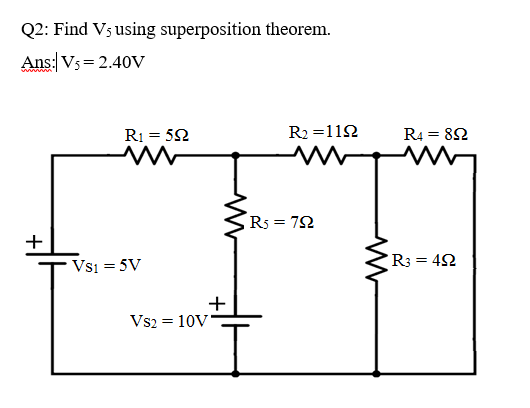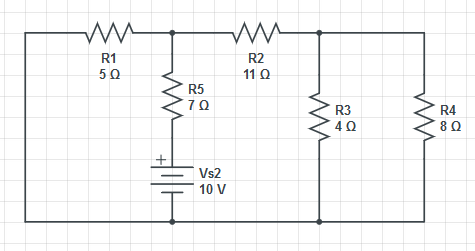I have to find voltage across R5 using superposition theorem but the problem is that I have a voltage difference of 4.16V,
Solution:-
Shorting battery VS1
R34 =8/3Ω =2.67Ω (Solved R3 & R4 in parallel)
R234 =41/3Ω =13.67Ω (Solved R34 & R2 in series)
R1234 =205/56Ω =3.66Ω (Solved R234 & R1 in parallel)
Using Voltage Divider Formula on R5
(1)V5= 6.56V (Voltage when VS1 is shorted)
Shorting Battery VS2

R34 =8/3Ω =2.67Ω (Solved R3 & R4 in parallel)
R234 =41/3Ω =13.67Ω (Solved R34 & R2 in series)
R2345 =287/62Ω =4.62Ω (Solved R234 & R5 in parallel)
Using Voltage Divider Formula on R2345
Therefore, (2)V5=V2345= 2.40V(Voltage when VS2 is shorted)
Since the flow of voltage is opposite on R5 the resultant voltage(V5) can be obtained by taking the difference of the voltages obtained by shorting the batteries.
Resultant V5 =(1)V5 - (2)V5
Resultant V5 = 6.56 - 2.40
Resultant V5 = 4.16V
x------------------------------------------------------------x--------------------------------------------------------------------x
According to my solution after taking the difference at the end I'm obtaining a value of 4.16V of V5 but according to the given answer it says that the answer is 2.40V. I want to know that if there is something wrong with my solution or the answer provided is wrong?.



